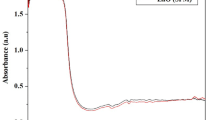Abstract
Silver nanoparticles (Ag NPs) are being increasingly used in many consumer products owing to their excellent antimicrobial properties. The continuous use of Ag NPs in consumer products will lead to environmental release. The present study evaluated the toxic effects and the possible underlying mechanism of Ag NPs on Pseudomonas putida. Ag NP exposure inhibited growth of the cells. Increased lipid peroxidation occurred coincident with suppression of the antioxidant defense system. Ag NP exposure caused reactive oxygen species (ROS) production, glutathione depletion and inactivation of the antioxidant enzyme superoxide dismutase, catalase and glutathione reductase. The addition of superoxide dismutase or pretreatment of P. putida with N-acetyl cysteine that quenches ROS reduced toxicity of the NPs.






Similar content being viewed by others
References
Woodrow Wilson Institute (2009) Nanotechnology consumer product inventory. http://www.nanotechproject.org/inventories/consumer/analysis_draft/
Mueller NC, Nowack B (2008) Exposure modeling of engineered nanoparticles in the environment. Environ Sci Technol 42:4447–4453
Boxall A, Chaudhry Q, Jones A, Jefferson B, Watts C (2008) Current and future predicted environmental exposure to engineered nanoparticles: report to Defra
Senjen R (2007) Nanosilver—a threat to soil, water and human health?. Friends of the Earth, Australia
Impellitteri CA, Tolaymat TM, Scheckel KG (2009) The speciation of silver nanoparticles in antimicrobial fabric before and after exposure to a hypochlorite/detergent solution. J Environ Qual 38:1528–1530
Kaegi R, Sinnet B, Zuleeg S, Hagendorfer H et al (2010) Release of silver nanoparticles from outdoor facades. Environ Pollut 158:2900–2905
Khan SS, Srivatsan P, Vaishnavi N, Mukherjee A, Chandrasekaran N (2011) Interaction of silver nanoparticles (SNPs) with bacterial extracellular proteins (ECP) and its adsorption isotherms and kinetics. J Hazard Mater 192:299–306
Khan SS, Mukherjee A, Chandrasekaran N (2011) Impact of exopolysaccharides on the stability of silver nanoparticles in water. Water Res 45:5184–5190
Dasari TP, Hwang HM (2010) The effect of humic acids on the cytotoxicity of silver nanoparticles to a natural aquatic bacterial assemblage. Sci Total Environ 408:5817–5823
Wigginton NS, DeTitta A, Piccapietra F, Dobias J et al (2010) Binding of silver nanoparticles to bacterial proteins depends on surface modifications and inhibits enzymatic activity. Environ Sci Technol 44:2163–2168
Khan SS, Mukherjee A, Chandrasekaran N (2011) Studies on interaction of colloidal silver nanoparticles (SNPs) with five different bacterial species. Colloid Surf B 87:129–138
Thompson DG, Enright A, Faulds K, Smith WE, Graham D (2008) Ultrasensitive DNA detection using oligonucleotide–silver nanoparticle conjugates. Anal Chem 80:2805–2810
Bar-Or D, Rael LT, Lau EP, Rao NK, Thomas GW, Winkler JV et al (2001) An analog of the human albumin N-terminus (Asp-Ala-His-Lys) prevents formation of copper-induced reactive oxygen species. Biochem Biophys Res Commun 284:856–862
Oyama Y, Hayashi A, Ueha T, Maekawa K (1994) Characterization of 2′,7′-dichlorofluorescin fluorescence in dissociated mammalian brain neurons: estimation on intracellular content of hydrogen peroxide. Brain Res 635:113–117
Winterbourn C, Hawkins R, Brian M, Carrell R (1975) The estimation of red cell superoxide dismutase activity. J Lab Clin Med 85:337–341
Beers RF, Sizer IW (1952) A spectrophotometric method for measuring the breakdown of hydrogen peroxide by catalase. J Biol Chem 195:133–140
Moron MS, Kepeierre JW (1979) Levels of glutathione reductase and glutathione S-transferase activities in rat lung and liver. Biochem Biophys Acta 582:67–68
Pal S, Tak YK, Song JM (2007) Does the antibacterial activity of silver nanoparticles depend on the shape of the nanoparticle? A study of the gram-negative bacterium Escherichia coli. Appl Environ Microbiol 73:1712–1720
Ruparelia JP, Chatterjee AK, Duttagupta SP, Mukherji S (2008) Strain specificity in antimicrobial activity of silver and copper nanoparticles. Acta Biomater 4:707–716
El-Badawy AM, Silva RG, Morris B, Scheckel KG et al (2011) Surface charge-dependent toxicity of silver nanoparticles. Environ Sci Technol 45:283–287
Jiang JK, Oberdorster G, Biswas P (2009) Characterization of size, surface charge, and agglomeration state of nanoparticle dispersions for toxicological studies. J Nanopart Res 11:77–89
Carlson C, Hussain SM, Schrand AM, Braydich-Stolle LK et al (2008) Unique cellular interaction of silver nanoparticles: size-dependent generation of reactive oxygen species. J Phys Chem B 112:13608–13619
AshaRani PV, Mun GLK, Hande MP, Valiyaveettil S (2009) Cytotoxicity and genotoxicity of silver nanoparticles in human cells. ACS Nano 3:279–290
Krishnaraj C, Jagan EG, Rajasekar S, Selvakumar P et al (2010) Synthesis of silver nanoparticles using Acalypha indica leaf extracts and its antibacterial activity against water borne pathogens. Colloid Surf B 76:50–56
Sondi I, Salopek-Sondi B (2004) Silver nanoparticles as antimicrobial agent: a case study on E. coli as a model for Gram-negative bacteria. J Colloid Interface Sci 275:177–182
Navarro E, Piccapetra F, Wagner B, Marconi F et al (2008) Toxicity of silver nanoparticles to Chlamydomonas reinhardtii. Environ Sci Technol 42:8959–8964
Yamanaka M, Hara K, Kudo J (2005) Bactericidal actions of a silver ion solution on Escherichia coli, studied by energy-filtering transmission electron microscopy and proteomic analysis. Appl Environ Microbiol 71:7589–7593
Li N, Xia T, Nel AE (2008) The role of oxidative stress in ambient particulate matter-induced lung diseases and its implications in the toxicity of engineered nanoparticles. Free Radic Biol Med 44:1689–1699
Kim JS, Kuk E, Yu KN, Kim JH et al (2007) Antimicrobial effects of silver nanoparticles. Nanomedicine NBM 3:95–101
Feinendegen LE (2002) Reactive oxygen species in cell responses to toxic agents. Hum Exp Toxicol 21:85–90
Acknowledgments
Authors thank Science and Engineering Research Board, Department of Science and Technology, Government of India for providing funding (SB/FT/LS-281/2012) to carry out our research.
Author information
Authors and Affiliations
Corresponding author
Rights and permissions
About this article
Cite this article
Sudheer Khan, S., Ghouse, S.S. & Chandran, P. Toxic effect of environmentally relevant concentration of silver nanoparticles on environmentally beneficial bacterium Pseudomonas putida . Bioprocess Biosyst Eng 38, 1243–1249 (2015). https://doi.org/10.1007/s00449-015-1365-z
Received:
Accepted:
Published:
Issue Date:
DOI: https://doi.org/10.1007/s00449-015-1365-z




